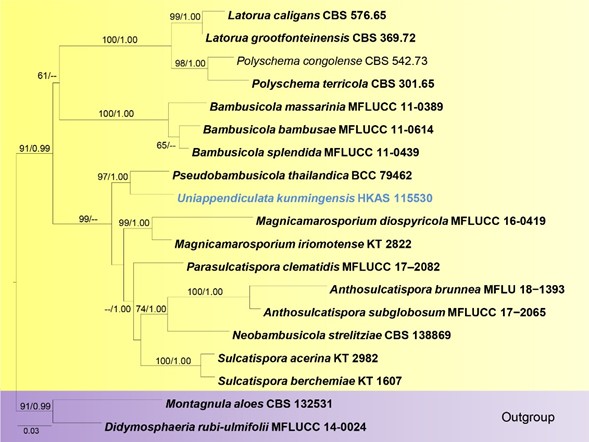Uniappendiculata Tibpromma, gen. nov.
Index Fungorum Number: IF558615; Facesoffungi number: FoF10421
Etymology – Referring to the single appendage conidia.
Saprobic dead stem of Acer palmatum.
Sexual morph: Undetermined.
Asexual morph: Conidiomata acervular, superficial, solitary, scattered, setae formed on cushions of brown to black. Conidiophores hyaline, simple or septate, branched, smooth-walled. Conidiogenous cells enteroblastic, phialidic, hyaline, smooth-walled, cylindrical, ellipsoidal. Conidia subcylindrical,
slightly curved, obtuse at apex, multi-septate, sometimes constricted at septum, hyaline, guttulate, thick-walled, with one appendage at each end.
Type species: – Uniappendiculata kunmingensis
Notes: – Sulcatisporaceae was introduced by Tanaka et al. (2015) to accommodate Magnicamarosporium, Neobambusicola and Sulcatispora in Pleosporales. Sexual morphs of Sulcatisporaceae are characterized by immersed to erumpent, subglobose to hemisphaerical ascomata, short ostiolar necks, trabeculate pseudoparaphyses, clavate, broadly fusiform ascospores with hyaline, septate and mucilaginous appendages (Liew et al. 2000, Tanaka et al. 2015). The asexual morph has pycnidial conidiomata with various conidial characteristics (Tanaka et al. 2015, Phukhamsakda et al. 2017, 2020, Rupcic et al. 2018). Phylogenetic analysis of ITS, tef1-α and LSU sequence data indicates that one new collection from Yunnan, China, is a distinct genus in Sulcatisporaceae, which forms a clade sister to Pseudobambusicola (Fig. 6). However, Pseudobambusicola forms micro and macroconidia but our new genus forms only macroconidia. Based on morphology show macroconidia of Pseudobambusicola in having fusoid-ellipsoid, prominently guttulate, hyaline, smooth, 0–3-septate which differ from our new genus (Rupcic et al. 2018). A comparison of ITS, LSU and tef1-α gene regions indicate 50 bp (ITS), 12 bp (LSU), 52 bp (tef1-α) differences between the type species of Pseudobambusicola (BCC 79462) with our new genus. Hence, the new genus, Uniappendiculata is herein introduced. Uniappendiculata can be distinguished from other members in Sulcatisporaceae by subcylindrical, multi-septate, hyaline conidia with one appendage at each end.
Acer species are widely grown as ornamental plants and reported with numerous fungi (Sutton 1980, Nag Raj 1993, Farr & Rossman 2021). Currently, 367 records of microfungi inhabiting Acer have been reported from China (Farr & Rossman 2021). However, we predict that a large number of novel taxa are yet to be discovered from Acer species in South-Western China.

Figure 6 – The best scoring RAxML tree with a final likelihood value of -9124.516643 for combined dataset of LSU, tef1-α and ITS sequence data. The tree is rooted with Montagnula aloes (CBS 132531) and Didymosphaeria rubi-ulmifolii (MFLUCC 14-0024). The matrix had 547 distinct alignment patterns with 24.64% undetermined characters and gaps. Estimated base frequencies were as follows: A = 0.228527, C = 0.263570, G = 0.278846, T = 0.229057; substitution rates: AC = 1.094587, AG = 1.973297, AT = 1.123227, CG = 0.720850, CT = 5.866173, GT = 1.000000; gamma distribution shape parameter α = 0.165842. The newly generated sequence is in blue. Bootstrap support values for ML equal to or greater than 60% and BYPP equal to or greater than 0.90 are given above and below the nodes, respectively.
Species
